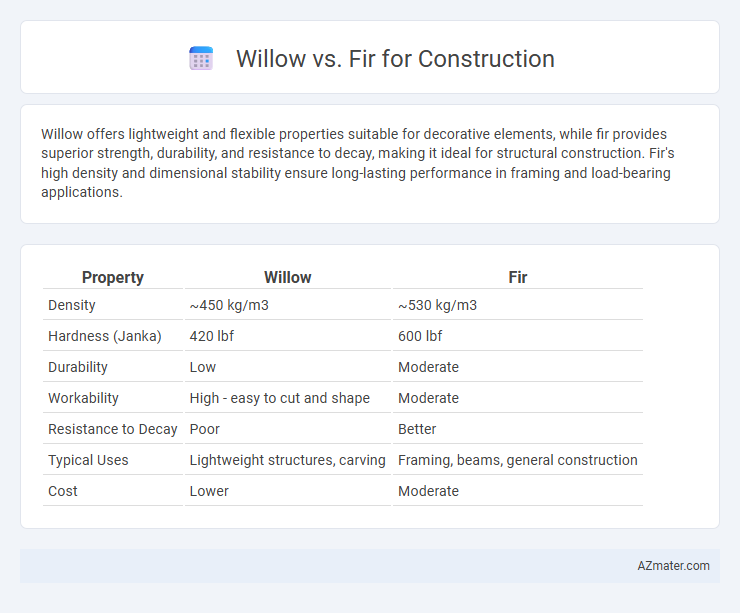Willow offers lightweight and flexible properties suitable for decorative elements, while fir provides superior strength, durability, and resistance to decay, making it ideal for structural construction. Fir's high density and dimensional stability ensure long-lasting performance in framing and load-bearing applications.
Table of Comparison
| Property | Willow | Fir |
|---|---|---|
| Density | ~450 kg/m3 | ~530 kg/m3 |
| Hardness (Janka) | 420 lbf | 600 lbf |
| Durability | Low | Moderate |
| Workability | High - easy to cut and shape | Moderate |
| Resistance to Decay | Poor | Better |
| Typical Uses | Lightweight structures, carving | Framing, beams, general construction |
| Cost | Lower | Moderate |
Introduction to Willow and Fir in Construction
Willow wood, known for its lightweight and flexibility, finds limited use in construction primarily for non-structural elements, crafts, and decorative purposes. Fir wood, particularly Douglas Fir, is highly valued in construction for its strength, durability, and resistance to warping, making it suitable for framing, beams, and structural supports. The contrasting wood densities--willow's low density versus fir's high density--dictate their respective applications within the construction industry.
Wood Properties: Willow vs Fir
Fir wood exhibits higher density and strength compared to willow, making it more suitable for structural construction requiring load-bearing capacity. Willow wood is softer with lower hardness and durability, often used for lightweight applications or interior finishes rather than heavy framing. Fir's superior resistance to warping and decay enhances its longevity in outdoor and high-stress environments, whereas willow's tendency to absorb moisture limits its use in such conditions.
Strength and Durability Comparison
Willow wood, known for its lightweight and moderate flexibility, lacks the compressive strength and hardness required for heavy construction compared to fir. Fir, especially Douglas fir, offers superior strength, durability, and resistance to compression, making it a preferred choice for load-bearing structures and framing. Its high strength-to-weight ratio and natural resistance to decay result in longer-lasting performance in construction applications.
Workability and Ease of Processing
Willow wood offers superior workability due to its lightweight and soft texture, allowing for easy cutting, shaping, and nailing without excessive tool wear. Fir, while denser and harder, provides good ease of processing but may require sharper tools and more effort to achieve precise cuts and finishes. Both species are favored for construction, with willow preferred for projects needing quick fabrication and fir chosen for sturdier, longer-lasting structural components.
Resistance to Rot and Insects
Fir wood offers superior resistance to rot and insects compared to willow, making it a more durable option for construction projects exposed to moisture and pests. Willow tends to be softer and more susceptible to decay and insect damage, requiring additional treatment for outdoor use. Fir's natural density and resin content provide enhanced protection, reducing maintenance and extending the lifespan of structural elements.
Environmental Impact and Sustainability
Willow wood, known for its rapid growth and renewability, offers a more sustainable option in construction compared to fir, which grows slower and often requires longer reforestation periods. Fir, though structurally strong and commonly used, can contribute to higher carbon footprints due to intensive logging and slower forest regeneration. Choosing willow supports reduced deforestation rates and promotes carbon sequestration, aligning construction projects with more environmentally responsible practices.
Cost and Availability
Willow wood is generally more affordable than fir due to its faster growth rate and widespread availability in temperate regions, making it a cost-effective choice for budget-sensitive construction projects. Fir, while slightly more expensive, offers greater structural strength and durability, which can justify its higher price for load-bearing applications. Availability of fir is more limited compared to willow, as fir trees require specific climatic conditions, often leading to higher transportation costs in regions where fir is less common.
Best Applications for Willow Wood
Willow wood is best suited for lightweight construction projects such as crafting furniture, pallets, and temporary structures due to its flexibility and resistance to splitting. Unlike fir, which is preferred for structural framing because of its strength and durability, willow is more advantageous in applications where ease of shaping and shock absorption are critical. Its natural resilience to impact makes it an ideal choice for sporting goods and decorative elements in construction.
Best Uses for Fir Wood
Fir wood stands out in construction for its exceptional strength-to-weight ratio and durability, making it ideal for framing, beams, and structural supports. Its straight grain and fine texture allow for easy machining and excellent nail-holding capacity, enhancing stability and longevity in building projects. Unlike willow, which is softer and less dense, fir provides superior resistance to shrinking and warping, ensuring reliable performance in both interior and exterior applications.
Choosing the Right Wood: Willow or Fir?
Fir wood offers excellent strength, durability, and resistance to warping, making it a preferred choice for structural framing and heavy load-bearing construction. Willow, while lighter and easier to work with, lacks the robustness and long-term stability required for most construction projects, limiting its use primarily to decorative or non-structural elements. Choosing fir over willow ensures enhanced structural integrity and longevity in building applications.

Infographic: Willow vs Fir for Construction
 azmater.com
azmater.com